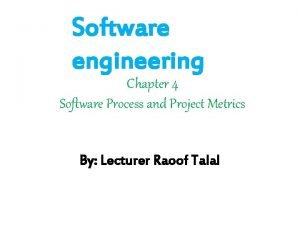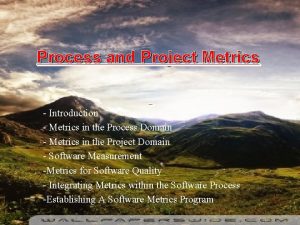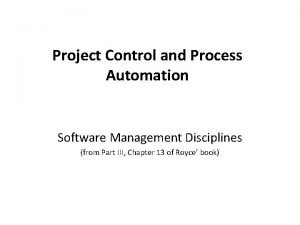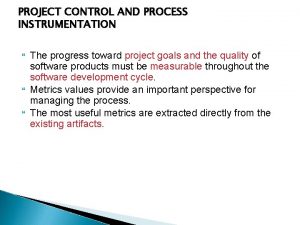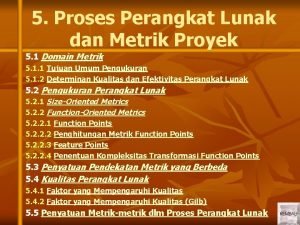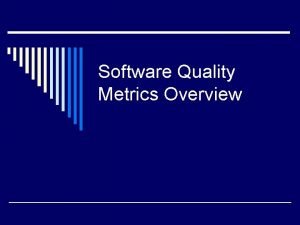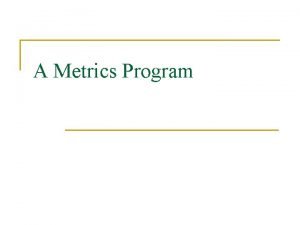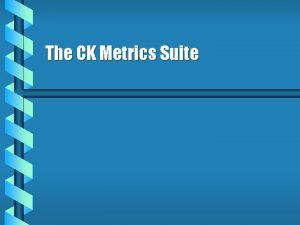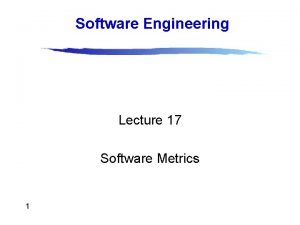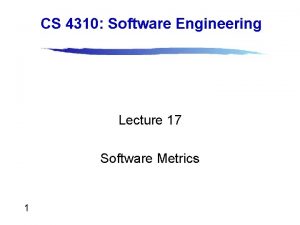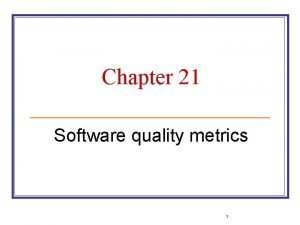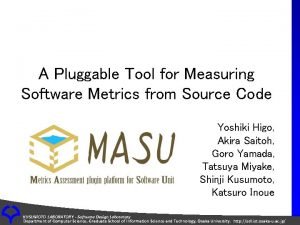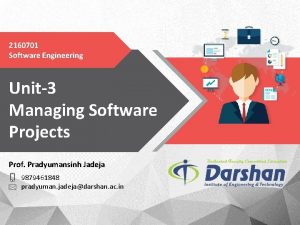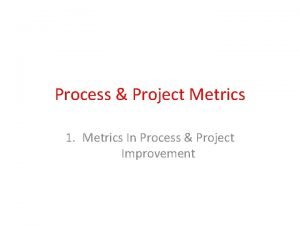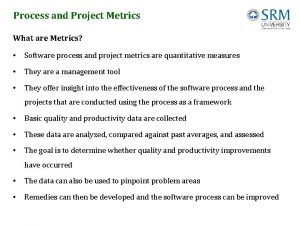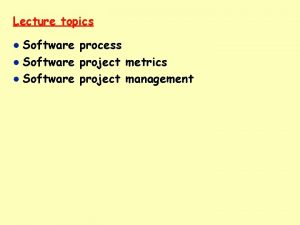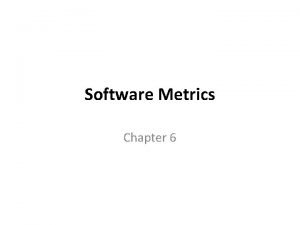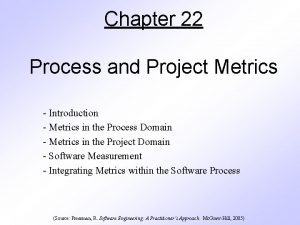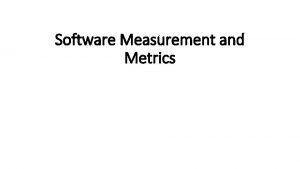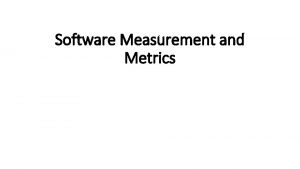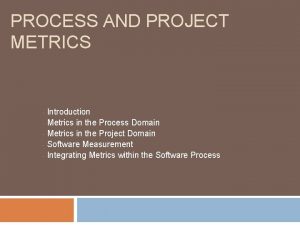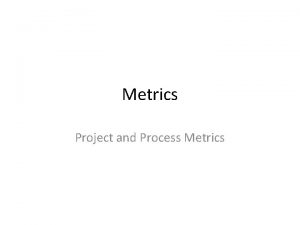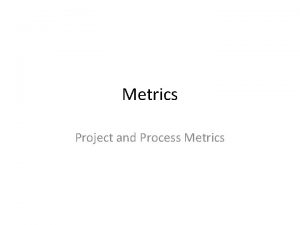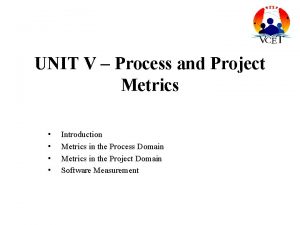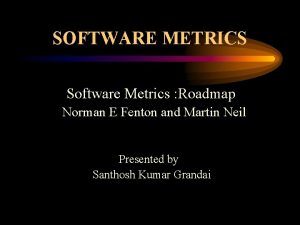Chapter 4 Software Process and Project Metrics These


















- Slides: 18

Chapter 4 Software Process and Project Metrics These courseware materials are to be used in conjunction with Software Engineering: A Practitioner’s Approach, 5/e and are provided with permission by R. S. Pressman & Associates, Inc. , copyright © 1996, 2001 1

Measurement & Metrics. . . collecting metrics is too hard. . . it's too time-consuming. . . it's too political. . . it won't prove anything. . . Anything that you need to quantify can be measured in some way that is superior to not measuring it at all. . Tom Gilb These courseware materials are to be used in conjunction with Software Engineering: A Practitioner’s Approach, 5/e and are provided with permission by R. S. Pressman & Associates, Inc. , copyright © 1996, 2001 2

Why do we Measure? To characterize To evaluate To predict To improve These courseware materials are to be used in conjunction with Software Engineering: A Practitioner’s Approach, 5/e and are provided with permission by R. S. Pressman & Associates, Inc. , copyright © 1996, 2001 3

A Good Manager Measures process metrics project metrics measurement product metrics product What do we use as a basis? • size? • function? These courseware materials are to be used in conjunction with Software Engineering: A Practitioner’s Approach, 5/e and are provided with permission by R. S. Pressman & Associates, Inc. , copyright © 1996, 2001 4

Process Metrics majority focus on quality achieved as a consequence of a repeatable or managed process statistical SQA data error categorization & analysis defect removal efficiency propagation from phase to phase reuse data These courseware materials are to be used in conjunction with Software Engineering: A Practitioner’s Approach, 5/e and are provided with permission by R. S. Pressman & Associates, Inc. , copyright © 1996, 2001 5

Project Metrics Effort/time per SE task Errors uncovered per review hour Scheduled vs. actual milestone dates Changes (number) and their characteristics Distribution of effort on SE tasks These courseware materials are to be used in conjunction with Software Engineering: A Practitioner’s Approach, 5/e and are provided with permission by R. S. Pressman & Associates, Inc. , copyright © 1996, 2001 6

Product Metrics focus on the quality of deliverables measures of analysis model complexity of the design internal algorithmic complexity architectural complexity data flow complexity code measures (e. g. , Halstead) measures of process effectiveness e. g. , defect removal efficiency These courseware materials are to be used in conjunction with Software Engineering: A Practitioner’s Approach, 5/e and are provided with permission by R. S. Pressman & Associates, Inc. , copyright © 1996, 2001 7

Metrics Guidelines Use common sense and organizational sensitivity when interpreting metrics data. Provide regular feedback to the individuals and teams who have worked to collect measures and metrics. Don’t use metrics to appraise individuals. Work with practitioners and teams to set clear goals and metrics that will be used to achieve them. Never use metrics to threaten individuals or teams. Metrics data that indicate a problem area should not be considered “negative. ” These data are merely an indicator for process improvement. Don’t obsess on a single metric to the exclusion of other important metrics. These courseware materials are to be used in conjunction with Software Engineering: A Practitioner’s Approach, 5/e and are provided with permission by R. S. Pressman & Associates, Inc. , copyright © 1996, 2001 8

Normalization for Metrics These courseware materials are to be used in conjunction with Software Engineering: A Practitioner’s Approach, 5/e and are provided with permission by R. S. Pressman & Associates, Inc. , copyright © 1996, 2001 9

Typical Size-Oriented Metrics errors per KLOC (thousand lines of code) defects per KLOC $ per LOC page of documentation per KLOC errors / person-month LOC person-month $ / page of documentation These courseware materials are to be used in conjunction with Software Engineering: A Practitioner’s Approach, 5/e and are provided with permission by R. S. Pressman & Associates, Inc. , copyright © 1996, 2001 10

Typical Function-Oriented Metrics errors per FP (thousand lines of code) defects per FP $ per FP pages of documentation per FP FP person-month These courseware materials are to be used in conjunction with Software Engineering: A Practitioner’s Approach, 5/e and are provided with permission by R. S. Pressman & Associates, Inc. , copyright © 1996, 2001 11

Why Opt for FP Measures? These courseware materials are to be used in conjunction with Software Engineering: A Practitioner’s Approach, 5/e and are provided with permission by R. S. Pressman & Associates, Inc. , copyright © 1996, 2001 12

Computing Function Points These courseware materials are to be used in conjunction with Software Engineering: A Practitioner’s Approach, 5/e and are provided with permission by R. S. Pressman & Associates, Inc. , copyright © 1996, 2001 13

Analyzing the Information Domain These courseware materials are to be used in conjunction with Software Engineering: A Practitioner’s Approach, 5/e and are provided with permission by R. S. Pressman & Associates, Inc. , copyright © 1996, 2001 14

Taking Complexity into Account These courseware materials are to be used in conjunction with Software Engineering: A Practitioner’s Approach, 5/e and are provided with permission by R. S. Pressman & Associates, Inc. , copyright © 1996, 2001 15

Measuring Quality Correctness — the degree to which a program operates according to specification Maintainability—the degree to which a program is amenable to change Integrity—the degree to which a program is impervious to outside attack Usability—the degree to which a program is easy to use These courseware materials are to be used in conjunction with Software Engineering: A Practitioner’s Approach, 5/e and are provided with permission by R. S. Pressman & Associates, Inc. , copyright © 1996, 2001 16

Defect Removal Efficiency DRE = (errors) / (errors + defects) where errors = problems found before release defects = problems found after release These courseware materials are to be used in conjunction with Software Engineering: A Practitioner’s Approach, 5/e and are provided with permission by R. S. Pressman & Associates, Inc. , copyright © 1996, 2001 17

Managing Variation The m. R Control Chart These courseware materials are to be used in conjunction with Software Engineering: A Practitioner’s Approach, 5/e and are provided with permission by R. S. Pressman & Associates, Inc. , copyright © 1996, 2001 18
 Process and project metrics in software engineering
Process and project metrics in software engineering Project metrics in software engineering
Project metrics in software engineering Software measurement and metrics in software engineering
Software measurement and metrics in software engineering Process and project metrics
Process and project metrics Seven core metrics in software project management
Seven core metrics in software project management Mtbf and maturity
Mtbf and maturity Metrics computer science
Metrics computer science Process indicators enable a software project manager to
Process indicators enable a software project manager to Process metrics in software engineering
Process metrics in software engineering Defect arrival pattern
Defect arrival pattern Limitations of software metrics
Limitations of software metrics Metrics for project size estimation
Metrics for project size estimation Ck metrics
Ck metrics Data structure metrics
Data structure metrics Function point metrics in software engineering
Function point metrics in software engineering Software productivity metrics formula
Software productivity metrics formula Software metrics tools
Software metrics tools Basic software engineering
Basic software engineering Richmond hill sustainability metrics
Richmond hill sustainability metrics
